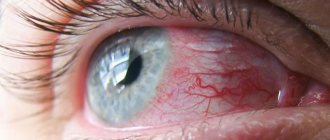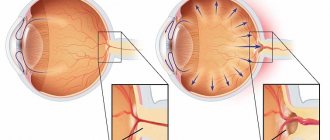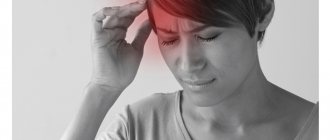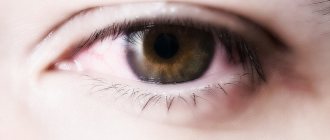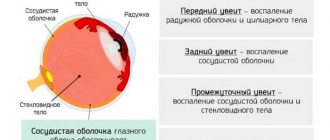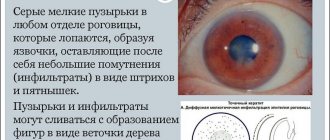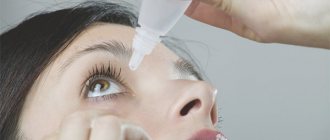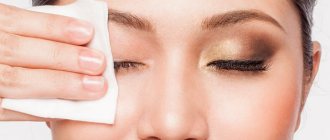Pain with stye
In everyday life, barley is an acute purulent inflammation of the eyelash bulb and the sebaceous gland around the hair follicle. The disease is caused by staphylococcus, and people with reduced immunity often suffer from styes.
First, pain is felt when pressing, and then redness and swelling of the eyelid occurs. The swelling increases, which sometimes causes the palpebral fissure to decrease. After a few days, an abscess with a yellow head forms on the eyelid. Inflammation may be accompanied by signs of malaise: fever, swollen lymph nodes, headache.
As soon as the abscess opens on its own, the pain gradually disappears and health improves. You should not try to squeeze out the pus; this can lead to phlegmon, abscess and even meningitis.
Pain in the lower eyelid occurs due to stye
Sometimes several affected areas form on the eyelid, which merge with each other. An abscess may appear on the inside of the eyelid, this indicates inflammation of the sebaceous glands at the edges of the eyelid, this disease is called meibomitis. With this form of stye, the symptoms of the disease are less acute, and pus breaks into the conjunctival sac.
Barley is not as harmless a disease as it might seem. Complications are possible: abscess or phlegmon of the eyelid, infection in the brain.
Why does the lower eyelid hurt?
If you have stye, you should not apply heat or apply compresses to the sore eye. It is necessary to use antibacterial eye ointments Hydrocortisone, Floxal, as well as Levomycetin and Tsipromed drops. If the abscess does not mature for a long time, UHF therapy helps; it is carried out in the absence of elevated temperature.
Upper eyelid pain: prevention
Before you begin prevention and treatment, you need to know what not to do. The biggest mistake many people make is self-medication. In order to prevent the development of complications, it is best to visit a specialist. It is better to avoid using cosmetics and lenses for the entire treatment period.
In order to reduce pain and eliminate swelling, it is recommended to follow some rules:
1. People with chronic diseases should adjust their diet. Avoid eating salty and spicy foods.
2. The best way to recovery is proper sleep.
3. Choose good cosmetics, it is better if they are of plant origin.
Our eyes are always at risk - dust, sun, foreign objects. They need to be carefully looked after to prevent the development of diseases. It is recommended to visit a specialist several times a year for inspection. And of course, if something happens, do not delay visiting the hospital, do not overuse self-medication.
Furuncle and carbuncle of the eyelid
A boil (boil) may form on the eyelids. This occurs more often in people with oily and acne-prone skin. This location of the boil is considered dangerous due to the proximity of the brain.
First, a small pimple forms on the eyelid. A burning sensation is felt when touching the affected area. Over time, the pimple enlarges, becomes dense, painful and turns into a large abscess.
A boil on the lower eyelid must be distinguished from a stye. The suppuration of a boil is larger in size. It also cannot be squeezed out. You need to contact an ophthalmologist.
Purulent formation is treated with antibiotics, and ointments are applied topically to the affected area. Unlike barley, boils do not always break out quickly on their own. Sometimes the abscess has to be opened surgically.
In some cases, several boils merge into a single formation. On the eyelid you can notice a boil with many heads. Such a lesion is called a carbuncle. At the same time, your health worsens and your temperature rises. Carbuncle is treated with antibiotics and the use of disinfectant solutions and antibacterial ointments.
Pain in the lower eyelid occurs due to stye
Upper eyelid pain: diagnosis
At an appointment with an ophthalmologist, a specialist will evaluate the area of localization and examine changes in skin color. The doctor will also note whether the swelling is unilateral or bilateral, then you need to check your visual acuity.
By palpation and visual inspection, you can find out whether the local temperature in the area is increased, whether there is pain when touched or not. For example, if the eyelid is swollen on both sides and there is no pain, we can assume that this is a manifestation of an allergy.
Important! Unilateral swelling, with severe pain, may be caused by orbital cellulitis.
Thus, we can conclude that edema can be diagnosed only by the method of its clinical manifestation. That is why specialists rarely prescribe laboratory and instrumental methods for a complete examination of the eye. Additional diagnostics become necessary in case of injuries and vascular thrombosis.
When there is swelling of the upper eyelid and its examination, you need to take into account the skin fold; for many it sags greatly. This is more often observed in older people. If such an aesthetic defect is a hindrance for the patient, it can be corrected surgically.
Never try to relieve upper eyelid pain on your own by massaging or using warm compresses. Before diagnosing the disease, these actions are prohibited, as they can lead to complications.
Abscess and phlegmon of the lower eyelid
An abscess often develops as a complication after a stye, boil or carbuncle. In this case, more extensive inflammation and suppuration occurs than with a boil. The disease may begin with slight itching in the eye area. Then the eyelid droops, swells sharply and turns red.
In this case, not only the eye hurts, but also a severe headache is felt. The process of maturation of an abscess is difficult, and a sharp deterioration in health occurs. Therefore, doctors usually do not wait for the abscess to break out on its own, but open the abscess.
An untreated abscess can develop into phlegmon of the lower eyelid. The suppuration spreads further through the subcutaneous tissue. Severe swelling of the eyelid occurs, in which the palpebral fissure sometimes closes completely.
The eye begins to hurt unbearably, the person avoids even moving the eyeball. Because of this, vision is impaired and there is double vision. Cellulitis can only be treated surgically. First, the affected area is opened, then a drain is placed to drain the pus and a course of antibiotics is prescribed.
Abscess of the eyelid
Myositis
As a result of inflammation of the eye muscles, chaotic pain occurs when blinking, as well as severe swelling. The causes of the inflammatory process can be: hypothermia, prolonged work at the computer, mechanical damage, helminthic infestations, etc.
With myositis, pain occurs not only when blinking, but also when pressing
Treatment includes the use of both conservative techniques and surgical intervention.
Pain with conjunctivitis
Conjunctivitis is an inflammation of the mucous membrane of the eye. The disease occurs due to exposure to allergens or viral infection. The following symptoms are observed:
- a burning sensation in the eyes;
- redness of the sclera and the inside of the eyelids;
- discharge from the eyes;
- fear of light;
- sensation of a foreign body in the eye;
- dried pus on the eyelashes.
With this disease, the lower eyelid may swell, but it does not look as inflamed and red as with stye. Conjunctivitis is not accompanied by the formation of ulcers on the lower eyelid.
The pain is felt not on the skin, but on the inside of the eyelid. There is no increase in temperature, unless conjunctivitis is caused by a cold.
Types of conjunctivitis
This disease needs urgent treatment. Drops containing anesthetics and antiviral substances are injected into the eye. During therapy you should not use contact lenses or eye cosmetics.
People often try to save themselves from conjunctivitis by washing their eyes with tea leaves. However, this does not always help. If not treated sufficiently, the disease can become chronic.
What bad habits are associated with eye pain?
Bad habits that lead to impaired vision include smoking, alcoholism, and drug addiction. All toxic substances negatively affect blood vessels and nerve tissue.
Smoking reduces the flow of oxygen through the lungs into the blood. This causes hypoxia of organs, including the eyes. Smoking reduces the elasticity of the vascular endothelium. It becomes brittle, so in addition to hypoxia, the risk of hemorrhage increases.
With daily alcohol intake, ethanol accumulates in the blood and various tissues. It is toxic and leads to dysfunction of the nervous tissue (optic nerve, visual center of the brain).
Drugs destroy all tissues with which they interact. If they are used for a long time, they accumulate in the brain and optic nerve. This reduces visual acuity. Drugs disrupt the conduction of nerve impulses from cones and rods through the optic nerve to the brain. Lack of pupillary reflex is common.
Bad habits include prolonged use of electronic gadgets. They create a strain on the eyes, as the gaze concentrates only on nearby objects.
This results in a missing, curved lens. The condition is called spasm of accommodation. It causes myopia, that is, decreased visual acuity for distant objects.
Erysipelas of the lower eyelid
If a person has pain in the eyelid under the eye and at the same time there are red, inflamed areas on the face, then these may be signs of erysipelas. This is a disease caused by staphylococcus. Inflammation of the eyes rarely occurs in isolation; usually the infection spreads to the eyelid from other parts of the face. Symptoms of erysipelas are as follows:
- redness and peeling of the skin;
- febrile state (high temperature, chills);
- weakness;
- nausea;
- feeling of bursting pain in the affected areas;
- swelling of the inflamed areas.
Erysipelas
If you have such symptoms, you should call a doctor. Erysipelas is treated in a hospital setting. Intramuscular injections of antibiotics and vitamins are prescribed.
Homeopathic treatment
The upper eyelid hurts – can pain lead to vision loss? How to get rid of pain in the upper eyelid using conservative methods
Author: therapist Anna Denisova
Vision is an important process for a person’s full life, which allows him to receive an image and adapt to the environment.
Under the influence of many factors, visual acuity may decrease, the usual routine of life is disrupted, and unpleasant sensations arise.
A common situation that many people face is pain in the upper eyelid.
But what is this connected with and can it pose a serious danger?
Chalazion pain
A chalazion is an inflammatory process of the eyelid margin around the cartilage. The disease occurs due to blockage of the sebaceous glands. At the beginning of the disease, no external changes in the eye are observed.
But on the inner surface of the eyelid you can find a formation in the form of a small grain. Over time, the chalazion grows, the eyelid begins to hurt, and a feeling of a foreign body appears. A swollen area is visible under the eye.
A large formation inside the eyelid begins to rub and irritate the mucous membrane of the eye. Because of this, inflammation of the conjunctiva and cornea occurs. Vision deteriorates. Fistulas can form, and pus is released through them.
In advanced cases, eyelid defects occur—deformation and constant swelling. It is important not to confuse this disease with barley. With a chalazion, the swelling does not decrease, but only increases.
The inflammatory process in the peri-cartilaginous area does not go away on its own. Therefore, if the symptoms of barley do not go away for a long time, then perhaps this is due to a more serious pathology.
Lower eyelid pain
This disease can be cured without surgery only in the early stages. The doctor prescribes antibiotics, physiotherapy and massage sessions. If conservative treatment does not have an effect, then excision of the chalazion is performed.
How to relieve the condition at home?
When the eye under the upper eyelid hurts, not everyone knows what to do.
When a stye or boil appears, the doctor prescribes antimicrobial drops and/or ointments. In order to relieve inflammation and prevent possible consequences of complications.
After some time, the abscess opens and its contents come out. If this does not happen, it is possible to open the growth in a day hospital. In difficult cases, tableted antibacterial drugs are used.
It is strictly forbidden to open a boil or stye yourself, or pierce it with a needle or pin at home.
Inflammation of the eyes is relieved with drops; as mentioned above, if the disease is viral in nature, antiviral drugs are prescribed. In cases where the disease is complicated by a bacterial infection, the doctor prescribes special medications that fight germs and bacteria.
If a skull injury occurs, the eye hurts under the upper eyelid, or it hurts to blink, it is important to immediately consult an ophthalmologist.
Pain when moving for centuries
In some diseases, pain under the lower eyelid intensifies when blinking or moving the eyeballs. This symptom should alert you, as it may be associated with damage to the internal structures of the eye. Such pain is observed in the following diseases:
- Endophthalmitis. This is an inflammation of the vitreous body of the eye. The disease occurs after eye injury, infection during surgery, or as a complication of corneal ulcers. The pathology is dangerous, as in advanced cases it leads to loss of vision. At the same time, it hurts to press on the eye, but the pain is felt not in the skin, but in the sclera. With endophthalmitis, intraocular pressure drops, the eyelids swell, and vision deteriorates. Treatment is carried out in a hospital.
- Blepharitis. This is inflammation of the edges of the eyelids. It may occur with the formation of ulcers or scales on the affected area. With this pathology, the eyelids swell, turn red and hurt. When a person closes his eyes, the pain increases significantly. The edges of the eyelids thicken and discharge comes from the eyes. Blepharitis often affects children because their immune system is weak. The disease is difficult to treat, and relapses often occur. This pathology requires long-term treatment.
- Corneal ulcer. Ulcers occur due to injury, improperly fitted contact lenses, or infection. The eyelids swell and hurt, especially when blinking, there is an increased secretion of tear fluid, and blurred vision. The sclera of the eyes turn red, the pupils are reduced. Treatment is carried out with antibiotics and special eye drops to rest the eyes.
- Molluscum contagiosum. This is a viral disease that most often affects children. Small yellowish-white nodules form on the skin of the face and eyelids. These growths usually do not cause severe pain, but discomfort may be felt when pressing or blinking. The nodules are removed or cauterized with iodine. Without treatment, molluscum contagiosum goes away on its own within 6 months.
Types of blepharitis
Corneal ulcer
Prevention methods
Do you want to maintain your eye health? Follow a few recommendations:
- wash your hands before touching your face;
- get a good night's sleep;
- try to lead a healthy lifestyle, move more;
- do not get too cold;
- When working at a computer, try to take breaks on time and do eye exercises.
Simple rules will help you avoid possible problems. Do not forget that all medications for treatment are prescribed only by a doctor after diagnosis. Take care of your eyes!
Useful video
Pain when pressing or blinking indicates the presence of pathological conditions and fatigue of the visual apparatus. Regardless of the severity of the symptom, it is necessary to seek qualified help in a timely manner, since the progression of the disease leads to a clouding of the picture. Diseases such as keratitis or glaucoma can lead to complete loss of vision. Pain allows you to timely identify pathology and stop its further development.
Author's rating
Author of the article
Alexandrova O.M.
Articles written
2031
about the author
Was the article helpful?
Rate the material on a five-point scale!
( 2 ratings, average: 3.00 out of 5)
If you have any questions or want to share your opinion or experience, write a comment below.
